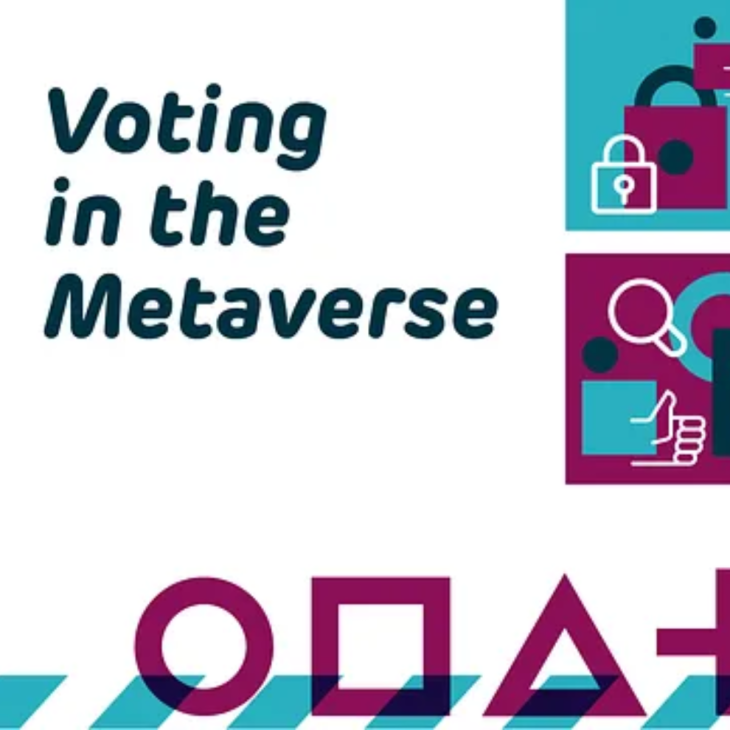
Voting in the metaverse
The Future of Online Elections?
The technology behind metaverses (or 3D virtual, social environments) has been coming for a while now. Developments in video games and virtual and augmented reality seemingly led to these kinds of online platforms since the early 2000s. However, the COVID-19 pandemic has also resulted in a unique context under which metaverses have become both widely relevant and discussed.
On the one hand, technology and virtual communication has become increasingly more prevalent in our daily lives. According to a recent survey, 90% of US citizens believe that the internet has been essential or important to them personally throughout the pandemic, and 40% say they have used technology in new and different ways since the pandemic began. Meanwhile, we are learning more about the impacts necessary social distancing practices have had on our sense of social connection, and many of us are looking for ways to connect digitally.
With ongoing advancements in technology and the continued influence of technology to both complete certain tasks and engage socially, metaverses seem like a logical next step for our daily activities from shopping and playing games, to attending work meetings. In the near future then, would it be possible to visit a virtual polling station and cast online votes for elections in the metaverse?
To answer this question, we can take a look at the factors we typically consider when evaluating a voting system: its security and integrity, its transparency, and its usability and accessibility.
The security of a voting system and the integrity of votes cast through that system are of utmost importance in ensuring fair and trustworthy elections. When voting online or over the internet, security and integrity are often guaranteed through a number of mechanisms including end-to-end encryption, digital signatures, and robust voter authentication protocols.
These same mechanisms would be vital to implement in any metaverse election in which votes are to be cast over the internet. However, we can imagine certain aspects of a metaverse election that would require additional security protocols as well.
If the intention behind allowing voters to cast ballots in the metaverse is to mimic in-person voting in a virtual setting, then certain processes need to be accounted for that don’t occur in traditional online voting.
For example, when voters enter the metaverse through their devices, they will be spawned into a virtual world where they can find a polling location, staffed by real poll workers who are also virtually present. As they would while voting in person, voters will then approach the entrance of the virtual polling station to verify their identity and eligibility with a poll worker. They will then proceed to a virtual poll booth and fill out a virtual ballot paper, then drop that paper in a virtual ballot box.
At each of these steps, specific security protocols would need to be developed to ensure that:
- The voter’s identifying information remains private and cannot be seen by anyone but the poll worker verifying their identity
- Each poll worker is properly authenticated and identified, so that voters know the virtual avatar they are interacting with and giving their identifying information to is a legitimate election worker
- No one can spy on the voter while they are filling out their ballot
- Unauthorized users cannot remove a voter’s ballot from the digital ballot box and view or manipulate its contents.
From a voter perspective, a metaverse election might at first appear more secure than voting through a typical online voting solution. While still transmitting ballots online, in a metaverse election, voters will be able to interact with real people and participate in a simulated poll station environment. For these reasons, it’s easy to assume that an election in the metaverse comes with the same security as an in-person election, but there are still many questions when it comes to protecting the security of the election and the integrity of the votes cast.
Different voting systems offer varying levels of transparency, like individual verifiability and universal verifiability. While in a paper election, voters can achieve partial individual verifiability through casting their ballot into the ballot box themselves. In a virtual metaverse election, though, this wouldn’t be the case unless specific security protocols are developed to prevent other virtual users from gaining access to the virtual ballot box. The individual verifiability mechanisms designed for online voting can (and should) also be implemented in a metaverse election.
Finally, any voting system is not worth using if it cannot be easily used by voters. Online voting solutions have clear advantages for voters with disabilities, as well as for older voters, and for voters in rural areas.
Unfortunately, there are a few readily apparent accessibility and usability issues with metaverse elections. The most obvious, perhaps, is that accessing a metaverse requires additional hardware, like virtual or augmented reality headsets (online voting systems often only require an internet connection). Not only are these devices expensive and not readily accessible to everyone, but they are also unfamiliar to a vast majority of people and require some technological know-how to operate.
Regarding voters with disabilities, it is no secret that many physical polling stations have features that hinder full election accessibility. While voters with certain disabilities would certainly gain accessibility through a virtual polling station environment, others, such as those with visual impairments or difficulties, might face even greater challenges.
